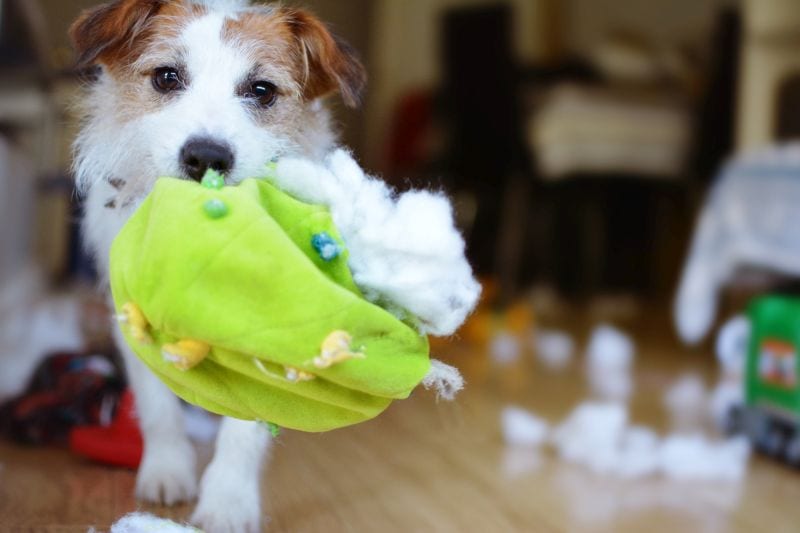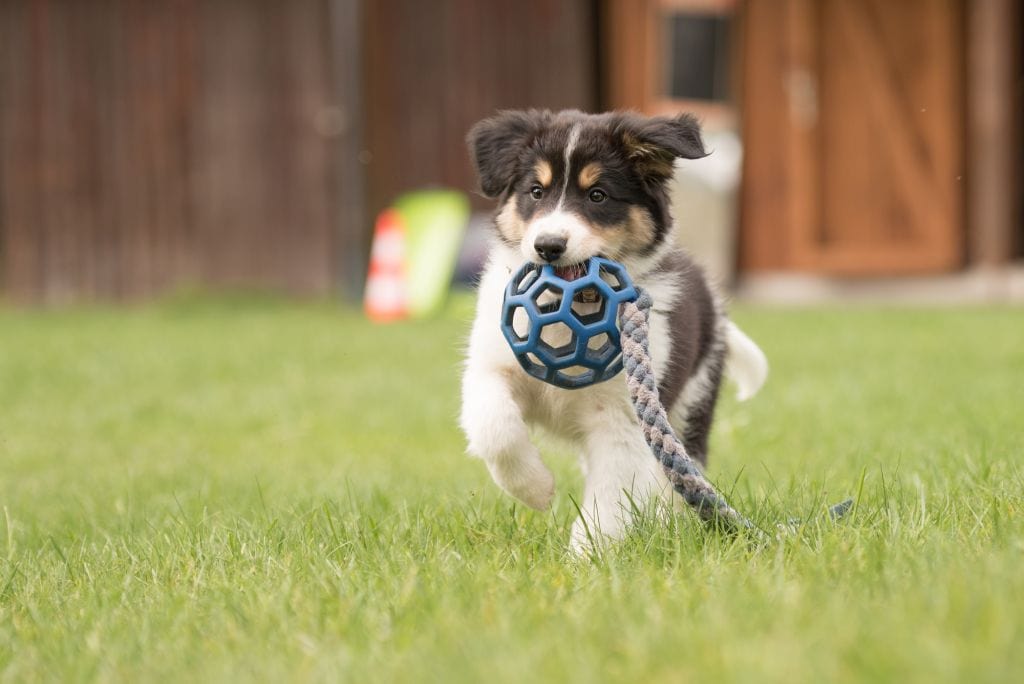Toys are essential for your dog’s well-being and choosing the right and safe toys can sometimes be challenging, especially with so many toys on the market.
Safety standards for dog playthings should approach those for a two-year-old-child, which will influence your decisions along with other factors like your dog’s age and the toy’s size, material, and type.
What to Consider Before You Pick
Dog Age
Young dogs are not only aggressive chewers, but they also are usually indiscriminate feeders. They explore everything with their mouths and swallow much of anything that ends up there.
All dogs can be prone to eat a foreign body (anything inedible), but puppies under six to eight months of age and particular breeds are especially vulnerable.
If you have a dog who will eat anything and everything, be especially careful about squeaky toys as your dog will try to remove the squeaker and perhaps swallow it. You should also be careful about small parts like glass eyes and metal buttons because your dog may accidentally swallow or choke on them.

Young dogs are rough on toys but may require soft playthings when they are teething and have sore gums. Consider teething rings and similar toys for puppies at four weeks old and again between the ages of four and seven months.
According to Pupbox.com, dogs often go through their most aggressive chewing phase well past teething, from 8 to 24 months. Chewing is an important part of a pup’s social development but may be prolonged in large breeds like Siberian Huskies and Labrador Retrievers.
Giant breeds over seven years old and other dogs over the age of ten years may have other problems like broken or worn teeth and they can benefit from softer toys.
Toy Size
Any toy you choose should be appropriate for your dog’s size. Small dogs can handle toys that may pose a choking hazard for giant breeds. In contrast, you will see playing ball toys that are too heavy or too large for puppies or toy breeds to carry or grasp.
Your dog’s size may also be a factor in the longevity of a particular toy. Although activity level can play a significant role in how long a toy will last, large dogs will typically destroy stuffed animals and other soft playthings quickly because of their strength.

Moreover, large dogs mature at a slower rate than small breeds. Combining additional size and weight with a long puppyhood is rough on toys, meaning more vigilant supervision on your part. Broken toys and torn stuffing can mean hazardous parts for your dog to eat.
Toy Materials
The two most important considerations for dog toy materials are durability and safety. Another crucial concern is washability.
Aggressive chewers require toys constructed with tough, hard materials. A few of the longest-lasting materials are rubber, rope, and nylon. Manufacturers of rope toys usually knit strands together, providing a significant increase in strength even though dogs still have the benefits of softness.
Plastic toys should be free of known toxic compounds like BPA and Phthalates. Also, check all sources of toys. Lead is still permissible in paint in a few countries.

If you have a powerful chewer, you need to keep a close eye on his interaction with toys. If your dog breaks a rubber toy and ingests one of the pieces, he could end up with an obstruction in his small intestine. As rope frays, the strings can also turn into a blockage if your dog eats enough of them.
Keeping reasonably sanitary conditions involves regularly cleaning your pet’s toys. Plastic and nonporous rubber materials are easy to wipe off, sanitize with sprays, or even put through the dishwasher. Nylon and fleece usually do well in the washing machine. Check toys for removable covers that are washable. From time to time, you may have to dispose of toys because you cannot remove stains or soiling.
Toy Types
Never underestimate your dog’s preference for certain toy types. Also, become knowledgeable about what the different toys can provide for your dog. Try to find a balance between how your dog enjoys playing and what you feel he needs.
For example, toys often can enhance training, and you should take every opportunity to make your pet’s education fun and interesting for him. In other cases, you may find your dog obtains comfort from a toy.
Training Toys
Training toys are ideal for dogs who are not very food-motivated. Shutzhund emphasizes the toy incentive in their guidelines regarding drive training. After a series of small treat rewards, a dog in drive training would get a play session with his favorite toy for a big job well done.
While Shutzhund builds a dog’s drive, you can also use some of its features to teach your dog how to play with toys and build interest in apathetic canines.

Training toys must be able to capture your dog’s attention and motivate him to learn and try to please you. In addition to helping with obedience training, toys can assist with getting dogs comfortable with entering a crate or an uncomfortable situation, relieving anxiety, and distracting from undesirable behaviors like biting.
Treat Dispensing Toys
A treat-dispensing toy should pass a few criteria before you deem it suitable for your dog. Your dog should have to work to get a treat out of a toy. If the holes are so big that the tidbits just drop out or your pet can simply crack the dispenser open, the toy is useless.

Treat-dispensing toys are great for a couple of options. They can provide a couple of hours or more of mental stimulation for your dog. Treat dispensers are also an excellent means to feed dogs who wolf down their food too fast.
You can find treat-dispensing toys in a variety of forms.
- Hard – Plastic or rubber, easy to clean, durable
- Soft – They may be easy for your dog to destroy; porous surfaces make them more difficult to clean; easier on your house and floors
- Balls that your pet rolls to get the treat
- Tug toys or dumbbells that your dog shakes to dispense the treats
Interactive Toys
Many toys can serve as interactive devices. With interactive toys, either you engage with your dog via the apparatus or your pet interacts directly with the object.
Generally, balls and ropes are examples of toys that are interactive between you and your dog. However, there are also electronic dog toys like self-fetching machines and robotic balls.

Some interactive toys are so sophisticated they can learn movements and sounds that stimulate your dog’s interest and encourage him to interact with it. Many of these toys allow you to monitor them remotely.
Self-Amusement Toys
Toys do not always have to be interactive to provide self-amusement for your dog. Have you ever seen a dog toss a rag doll in the air repeatedly and then pounce on it? What about dogs who play ball alone if no one is available? Many dog toys can fit into the self-amusement categories depending on what your dog likes.

In addition to the interactive and machinated wobble bars and vibrating spheres, you can also choose from tug balls, foraging mats, and puzzle games that do not require your participation.
Tug-of-war toys affix a ball by a rope to a stationary pole, similar to tetherball, and your dog pulls on it. Foraging or snuffle mats enable your dog to indulge in his favorite sense, smell. He can pretend to be at the dog park all day.
Comfort Toy
When you think of comfort toys for dogs, you may immediately imagine a stuffed teddy bear or colorful parrot. However, a comfort toy can be anything that consistently gives your pet a sense of calm.
If your dog plays vigorously with a tennis ball all day but then takes it with him to his dog bed or kennel to sleep, it is both an interactive and a comfort toy. Dogs like terriers and working dogs often treat comfort toys like pals, beating them up during the day and snuggling with them when resting. Hairless and toy breeds commonly use plush animals for comfort and warmth.

Puppies may use a comfort toy as a pacifier, even if it is not a teething ring. Comfort toys potentially wear out quickly, so always keep an eye out for a replacement. Size is important for comfort toys. If your dog likes to simply cuddle, an oversized stuffed animal is appropriate. If your pup likes to carry his toy around, you need to ensure it is of a manageable size.
Conclusion
Toys never take the place of your presence with your dog. Always supervise your pet with a new toy to make sure the interaction is safe. Once you are comfortable, do not leave your dog unsupervised, especially for longer periods of time.
Choosing the perfect toy is easier with the above criteria, but you may still need to experiment to find which toy best suits your pet.
